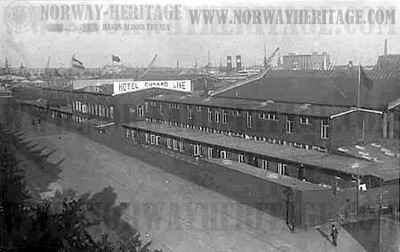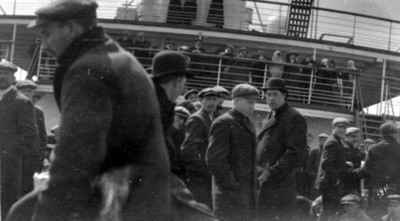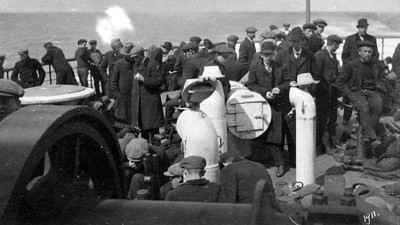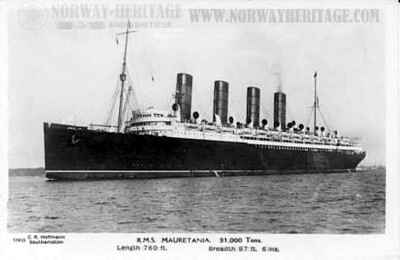A voyage from Norway to America in 1911
- Scott Thompson
This story was told by Bastian Fylling from Fyllingen in Hamre Parish north of Bergen. The story is about his voyage from Norway to America in 1911. It is presented by Scott Thompson
On the 8th of February at 9 p.m. they left Bergen on the steamship, Hera, belonging to the Bergen Line for Newcastle England. The Steamer stopped at two towns along the coast, Haugesrund and Stavanger before crossing the North Sea. In Haugesrund they took aboard 400 cases of iced Herring, as the spring herring run was on at the time of year in the area.
The next stop was Stavanger where we arrived at about, or shortly after 9 a.m.. We had a number of passengers along from Bergen, some for U.S.A. and also a crew for a new ship built in England for a Norwegian owner. In Stavanger more passengers came aboard and also some freight. Bert and I and a couple of other fellows from Lincoln County, who had been visiting Norway that same year went ashore for a little while; when we came aboard again, the mate of the ship handed me a telegram sent from Bergen the night before, and signed by Sigvart Kaalaas, Steffers Fyllingsness and one or to others. It read like this: God tur!* Friskt mot.* The last goodby. This was Feb. 9, and like the day before, a very nice day, rather warm for the time of year, and no wind. As we got away from the city we saw numerous fishing vessels moving north along the coast for the fishing grounds further up the coast, since there was no wind they were not making much headway. There was also numerous whales blowing, a sign that there was schools of herring in the sea. Sometime later we were called down for dinner. I was then standing on the after deck, looking back towards the land which was slowly sinking in the sea. I was rather hungry but would have liked to remain on deck to get the last glimpse of the old country; finally decided to go down, hurry back on deck and get that last glimpse then. I did hurry, but getting back up nothing but water to be seen in any direction. I felt sorry for a long time that I didn't stay up, even if I had lost my dinner. Perhaps it was lucky I ate, because it was the last meal I had til we arrived in New Castle in the evening of the next day Feb. 10. In the afternoon the wind came up, and since I've never been a very good sailor, I went to bed, and staid there for the rest of the time aboard. As it was getting dusk on Friday night the 10th, Bert came down and told me I better get up as we would soon be in port. And shortly thereafter we docked in South Shields, a little further down the Tyne river from Newcastle.
We had bought tickets from the Cunard Line agent in Bergen, and when we got ashore, the Line had a horsedrawn bus there to take us to the Rail Road Station as we had to cross England from Newcastle to Liverpool by rail. Got in to Liverpool at 4 a.m. Feb. 11th. The line provided transportation to a Hotel run by the Line only a few blocks from the Harbor. We were taken to a sort of ward in the Hotel with several beds and people in all of them except one.
 A Cunard Line Hotel for emigrants [Old postcard] A Cunard Line Hotel for emigrants [Old postcard] |
Bert Stephenson and John Eide took that one; the only other possible place was a bed with only one occupant, and I had to get in there. Don't know who my bedfellow was. To my certain knowledge, I've never seen him before or since. At seven a.m. the next morning, the clerk came in and told us to get down for breakfast. I was very sleepy, and couldn't see there was any hurry, so took another 5 minutes. The others went out, and in comes the clerk, on some nonsense, I had to get up now. Well, I did, being his insisted, and went to the dinning room for breakfast, last man. That's when I found out, the early bird catches the worm. Not much left fit to eat. The forenoon was spent showing our papers and getting some more papers, having doctor examinations etc. We had dinner and nothing more to do until it was time to board the ship between 3 and 4 p.m. I walked down to the harbor, as I was anxious to see the Ship we were to sail on. On the way down I also paid attention to the traffic on the streets. Somewhat different from Bergen but not too much. For transporting goods it was all done with horses at that time. They were also using two wheeled carts, same as at home, but bigger, and the horses were bigger than the Norwegian type. The driver, instead of using line, and driving the horse, would walk by the horses head leading the animal. Sometimes there were two horses on the cart, one in the shafts, the other in the lead, and then there was also two drivers, or should I say leaders. When I got down to the harbor, I saw two large steamers at anchor out in the harbor. They were the Mauritania and its sister ship the Lusitania. The last one was torpedoed off the coast of Ireland during the first world war, and between 1400 and 1500 people lost their life, among them many Americans. These two boats were the largest and fastest liners built up until then. I went back to the hotel, and a little later on, all the passengers walked down to the dock to board the ship. We were ferried out to the ship on a smaller steamer, a wheel boat, driven by two large wheels, one on either side of the boat. There were some 900 hundred of us, so when we got alongside the Mauritania, it took some time to get organized. We were lined up climbing the ladder from the smaller ship to the deck of the big one.
As the first four persons reached the deck a steward would lead them to their stateroom. The rooms were small about 6 x 8 feet, two bunks, one above the other on either side, with a narrow aisle between, hardly wide enough for two persons to squial by one another. If all four occupants were in the room, at least one would have to be lieing in bed in one of the upper bunks. There was a washstand by the wall across from the door and one folding chair. Our room was two stories down from the maindeck; the bathroom on the deck above us. After we had been disposed of, the ship was run along the dockside, where 1st and 2nd class passengers boarded the ship. Some freight and mail was also loaded. I have never been able to figure out why the 3rd class passengers had to be hauled into the harbor to board the ship, as long as they finally ran up to dockside anyway. The only reason occuring to me: It would save the lst and 2nd class passengers from getting in too close contact with "The Thundering Herd". We were due to leave at 6 p.m. on the 11th of Feb. It was on Saturday. It was, however, somewhat later before we left, but still daylight. The channel was marked with floating buoys, a long ways out to sea, and the ship had to keep within the marked channel to keep from running aground. When I came on deck the next morning (Sunday) the ship was standing by off Queenstown Irland. A smaller steamer was along side, with more passengers and mail for the States. On the bridgedeck of this smaller steamer sat a somewhat elderly man playing an accordion. He had lost one leg, in the Boer War I was told. Some of the passengers would throw him a coin now and again. Having finished our business there, we continued our journey along the Irish coast quiet a while. Some of the most interesting sights here, and again when we neared New York, was large sailing ships, looking almost like great white clouds floating on the sea when seen far off. Along in the afternoon the wind came up, and during the night, and for another day and night, the waves sounded like the thunder of canons every time they hit the side of the ship. Our room was near the starboard side where the wind and waves were coming from and I found it rather difficult to sleep on account of all the noise. The others in my room was: Bert Stephenson, John Eide and a young Norwegian immigrant from Fusa, about 30 miles south of Bergen. His first name was Gjert. I don't remember the last name. He was traveling with his uncle, who was a section foreman on the Milwaukee R.R. at Sheldon, Iowa, and who had also been visiting the old Country that winter. I had another bout with maldemes (seasickness) from Sunday night til Tuesday afternoon. By then the sea and wind was down some, and I finally managed to get up on deck.
There was a sort of store aboard, and I went there and bought some apples and oranges. And after eating some of them felt better. As I had not eaten anything since Sunday eve, I was kind of starved. From then on I had no more trouble with seasickness. On Thursday eve, Feb. 16th about 9 p.m. we anchored in New York's outer harbor off quarantine station. The next morning, Friday, we proceeded up the harbor to the docks at Hoboken. There was lots to see: Ferryboats, steamers, large and small tugs pulling large barges, some with several railroad cars on them. Then, of course, the Statue of Liberty, quite a Lady. A glimpse of Ellis Island that we later went through before finally getting on the railroad Chicago bound. We could also see the Brooklyn Bridge, hanging, something like an immense spider web across East river, and then we all got busy trying to count the stories of the tall buildings along the shore on lower Manhattan. We finally docked and went ashore. Our luggage came ashore, and had to be opened for custom inspection. Next both we and our luggage were put on a ferry and taken to Ellis Island. Getting off, we lined up two abreast, told to remove our hats and marched along a cement sidewalk up to the office building on the Island.
 Ellis Island [Old postcard] Ellis Island [Old postcard] |
On the way, a couple of doctors would look us over. They had a sort of tong, not unlike the curling irons women used to curl their hair with, before the unpermanent permanents came in style. With those they caught our upper eyelashes and turned up our eyelids. They were really good, we didn't even have to stop as we paced slowly by them. If we were passed, no marks were put on us, if they felt we needed closer examination, a chalkmark was put on your coat or overcoat, if you wore one. Inside, the building had alleys and pens, almost like the stockyards; we would pass up the alley with here and there a desk with a man behind it, to examine our papers and ask questions. In the end we were given our railroad tickets and were considered ready to enter the Promised Land. We got into a large assembly Hall with a counter along one sidewalk where we could buy eats and drinks, and also package lunch boxes to sustain us on the railroad trip to Chicago. These boxes were 50 cents or a dollar, the 50 cent box sufficient for one person, the dollar one for two. It turned out that this was unnecessary, as there was people selling hot bottled and creamed sweetened coffee and sandwiches, pie, fruit and candy bars on every station along the way, so we didn't eat much of the boxlunch. Back on the ferry we went to be landed at Weehawken across The Hudson River from N.Y. City. A train was set up there belonging to the Erie R. R. Before boarding the train, we entered a large round sort of building to wait til the train was to leave. I was thirsty and saw a man selling pop by a stand over by the wall. I went over, got a bottle of pop and went back to my seat to drink it. It was rootbeer, and didn't seem fit to drink, so taking just a sip I set the bottle on the floor and went back for another hoping he would give me a different kind, but no, rootbeer again, so down on the floor it went, and I tried it the third time, but it was still rootbeer, so I gave up. About 9 o'clock Saturday night we left N.Y. Our cars were old, and outmoded, but evidently considered good enough for such as us. We were put in 3 persons to a section, a section being 2 seats facing each other. A section at one end of the car was reserved for luggage. Suitcases were piled in there between the seats and in there almost to the ceiling. Bert, Gjert and I had one section. Gjert and I on the same seat so Bert had a whole seat to himself, and so could kind of lie down and sleep. I sat by the window and found it kind of drafty; so next morning my neck was kind of stiff, & furthermore it was kind of chilly. However, the next night when everybody was asleep, I crawled on top of the suitcases, stretched out and slept like atop, and up there near the ceiling it was nice and warm.
As soon as we were in the cars, the conductor locked the doors, and they were kept locked all the way to Chicago. On Saturday morning when it was light we must have been somewhere in western Pennsylvania. The road ran upstream along some river and with a fairly level riverbottom. Sometimes on both sides of the river, sometimes on just one side. There were farms along the bottomland, and I thought they looked pretty good then, though not very large. Up from the bottoms on both sides were fairly high ridges, very steep and overgrown with trees clear to the top. During the next night we left the mountains behind. I guess in the morning we were in Indiana and the country level prairie much like S.D. Nearing Chicago we could see trains here and there on different tracks. I could see up to five different trains at one time, and would sit and count the number of freightcars in each train.





